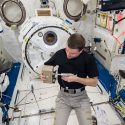Giant optical telescope in South Africa comes online
Five years after breaking ground on a South African mountaintop near the edge of the Kalahari desert, astronomers today (Sept. 1, 2005) released the first images captured by the Southern African Large Telescope (SALT), now the equal of the world’s largest optical telescope and a prized window to the night skies of the southern hemisphere.
With a 10- by 11-meter hexagonal segmented mirror and state-of-the-art scientific instrumentation, the new telescope was constructed by an international consortium of universities and government agencies. Partners include the National Research Foundation of South Africa, UW–Madison’s College of Letters and Science, Poland’s Nicolas Copernicus Astronomical Centre and Rutgers University, among others.
The new $18 million observatory will provide unprecedented access to the astronomically rich skies of the southern hemisphere. Objects such as the Large and Small Magellanic Clouds, the galaxies nearest to our own Milky Way, will come into sharp view through the concerted focus of the 91 hexagonal mirror segments that comprise the SALT Telescope’s primary mirror array.
“We’re now players in the world of large telescopes,” says Eric Wilcots, a UW–Madison professor of astronomy. “We’re in an age in which answering the big, fundamental questions requires access to large telescopes in good, dark skies. SALT is just such a telescope.”
Access to the southern sky, says Wilcots, promises a bounty of observing: “The southern Milky Way is more spectacular and provides a richer treasure trove of objects than the northern Milky Way.”
Moreover, studies of thousands of individual stars in the Magellanic Clouds are planned to trace the history of those nearby galaxies. The results of those studies, Wilcots explains, can be extrapolated to galaxies in general, providing a more refined life history of objects like our own Milky Way.
Other southern sky objects of interest, according to Kenneth Nordsieck, a UW–Madison astronomer now in South Africa to help with the SALT Telescope’s commissioning, include Eta Carina, a nearby massive star that has been racked by a series of enigmatic and spectacular explosions over the past century; Omega Centauri, a globular cluster of stars in the Milky Way that some astronomers believe may be the fossil remains of another galaxy consumed long ago by the Milky Way; and Centaurus A, a nearby galaxy that recently experienced an explosion at its core.
A critical advantage for the SALT Telescope, according to astronomers, is its location in one of the darkest regions of the world. With no nearby cities or towns, the observatory will be little affected by the light pollution that seriously hampers many observatories in the Northern Hemisphere.
Together with Rutgers University, another member of the SALT consortium, Wisconsin astronomers and engineers have constructed and are now integrating into the observatory the primary scientific instrument for the telescope, a device known as the Prime Focus Imaging Spectrograph. When in place six stories above the primary mirror array, the $5 million device will give the SALT Telescope specialized capabilities to capture and analyze starlight in unprecedented ways.
Spectrometers are designed to parse light into its constituent wavelengths. The spectra they obtain are revealing, providing astronomers with far more information than simple images. They can help show the chemical makeup of objects, depict motion, and some wavelengths of light enable astronomers to see through the obscuring clouds of dust and gas that permeate space.
One specialized capability of the Prime Focus Imaging Spectrograph, according to Nordsieck, is the ability to make observations in the near ultraviolet, the same kind of light that causes sunburn. “This is one of the few big instruments that will be good in the ultraviolet,” says Nordsieck.
The images released today through the South African Astronomical Observatory, the SALT Observatory’s parent organization, were taken with a digital camera known as SALTICAM. They include stunning pictures of the Lagoon Nebula, a luminous stellar nursery; the globular star cluster 47 Tucanae; and NGC6744, a barred spiral galaxy that astronomers consider almost a twin of our own Milky Way.
“The declaration of first light signifies that SALT has arrived on the astronomical scene,” according to a statement issues by the South African Astronomical Observatory. Although a months-long period of commissioning and shakedown remains, “SALT is now in a very real sense an operational telescope.”
A critical upcoming milestone will be the integration of the Wisconsin-built Prime Focus Imaging Spectrograph, envisioned as the workhorse instrument for the SALT Telescope. Capable of capturing high-resolution pictures, movies and the telltale spectra of objects such as stars, galaxies and comets, the device will be perched high above the light gathering primary mirror array at the heart of the new telescope.
Installation is expected in mid-September. “It is progressing in fits and starts, about the way one would expect with something of this complexity,” says Nordsieck. “In the meantime, the telescope team has worked out a lot of kinks so there should be a relatively smooth commissioning.”
The development of the SALT Observatory, says Wilcots, is “a beacon for Southern African science. It is meant to inspire a new generation of African scientists, which will be the lasting value of SALT to Southern Africa.”
For UW–Madison, the telescope project represents a bridge from Madison to South Africa. “Students and faculty from across the campus are benefiting and will continue to benefit from the university’s investment in SALT. We now have a student exchange program with the University of Cape Town and we will be initiating an exchange with the University of the Western Cape in November,” says Wilcots.
He emphasizes that the South Africans are making a statement with their investment in the giant telescope. “It is meant to showcase the capability of Southern African scientists and engineers – and it has done that,” Wilcots says. “Keep in mind that there are only a handful, perhaps as few as three, black South Africans with Ph.Ds in astronomy. While we have problems with an underrepresented minority in science, South Africa has an under-represented majority.”
Tags: business, research, space & astronomy



